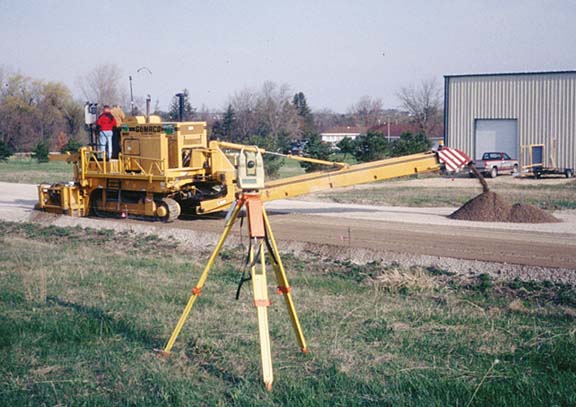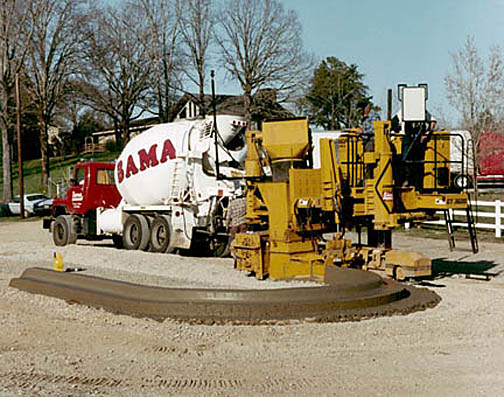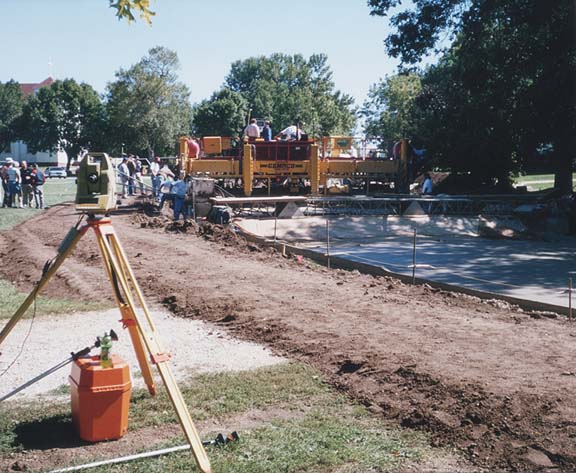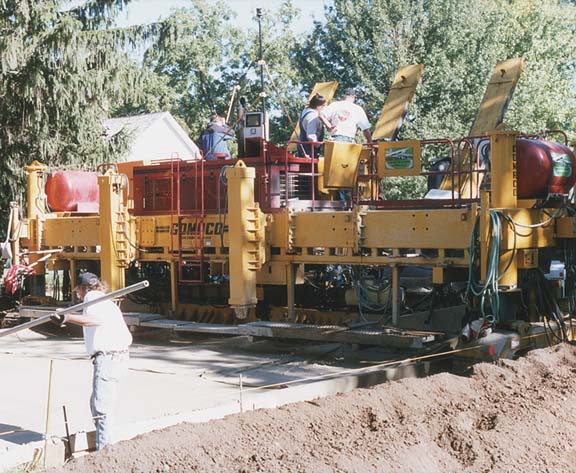GOMACO World Index --- GOMACO World 27.4 - January 2000
Stringless
GOMACO Corporation and Leica Geosystems, Inc., are developing the control system of the future. The new technology allows GOMACO's paving machines to be controlled by a Leica automated 3-D machine-control system and not by stringline.
"We feel we have an advantage over any of the other industry players because of our CAN- (controller area network) based Network Controller," Kevin Klein, GOMACO Research and Development Manager, said. "It's one of the key reasons the Leica system works with GOMACO equipment."
The process starts with a survey of the project site. The information gathered by the survey is used to create the project design or profile and create a 3-D picture.
Total stations are then set up on the job site at reference points set by the surveyors. A series of shots at the various reference points bring the total stations into the 3-D picture of the job site.
A Leica 3-D Command Center is mounted to the GOMACO equipment and is connected to the CAN bus of the Network Controller. The 3-D picture of the project is downloaded into the Command Center.
At this point, the total stations are in the 3-D picture of the job and the Command Center has been loaded with the site information. All that's left to do is bring the machine into the picture. To do this, shots are again taken from the total stations at prisms mounted on the machine.
The total stations, via radio link, send signals or coordinates back and forth to the Command Center mounted on the machine.
The information is constantly updated throughout the process. As the machine moves, the total stations track it and send radio signals back and forth to the Command Center at a rate of up to eight times per second. In milliseconds, the Command Center takes the real-time coordinate data and compares it to the the design-plan coordinate data. The Command Center places the information on the CAN bus network for the Network Controller to use to guide and steer the paver.
The stringless system has several advantages. It can accommodate radii or superelevations automatically according to design data. The real-time navigation system allows the project data created in the CAD system to be directly put into the paving process. The result is improved product quality, operational safety and work rate. Other advantages include uninterrupted control of the machine over long distances. Contractors have free choice of positioning for the total stations. There is no stringline installation or maintenance.
"The number one advantage is going to be the job site logistics. Contractors will be able to move their equipment around the site without having to worry about running over the stringline," Klein said. "With time, I think it's going to be a little more accurate and give a better performance than what a stringline job would. That's one of the major selling points of the system."
Over the past year, several tests and projects have been completed using the Leica stringless system and GOMACO machines. Some firsts in the concrete paving industry have been accomplished along the way.
World history was made in March of this year in Northport, Alabama. For the first time ever, a GT-3600 slipformed curb and gutter stringless using the Leica guidance system. The curb and gutter was slipformed by Shirley Concrete Company.
Forrest Avenue in Ida Grove, Iowa, became the first street in the United States to be paved with a stringless system in September. Godbersen-Smith Construction Company used a GP-2600 and the Leica system to slipform a roadway with integral curb 335m (1100 ft) long and 8.23m (27 ft) wide.
The Leica system has also been tested on GOMACO 9000 trimmers for several projects.
Although the system has only been tested on some of the machines, all GOMACO equipment with the Network Controller is adaptable to the system.
The stringless technology is still new and fairly complicated. On-site training for the system is anticipated to take two weeks for the first systems.
"As the system develops, it will obviously become more user friendly," Klein said. "I think eventually the contractors will be able to handle it better simply because they'll have hands-on, everyday practical use."
Until then, GOMACO and Leica are taking one step at a time while working towards a stringless future.
"What we want to do in the near term is put out three or four machines as beta sites or test sites," Klein said. "We don't want to put out more than we can support right now. It's still pretty new and and there's a lot of testing that has to be accomplished yet.
"Technology just keeps advancing and makes things better. I think a few years from now you're going to see this as the norm. It's going to happen."
This year, GOMACO Corporation and Leica Geosystems, based out of Heerbrugg, Switzerland, officially announced their cooperation in developing the stringless guidance system.
Subscribe to Receive GOMACO World Magazine




